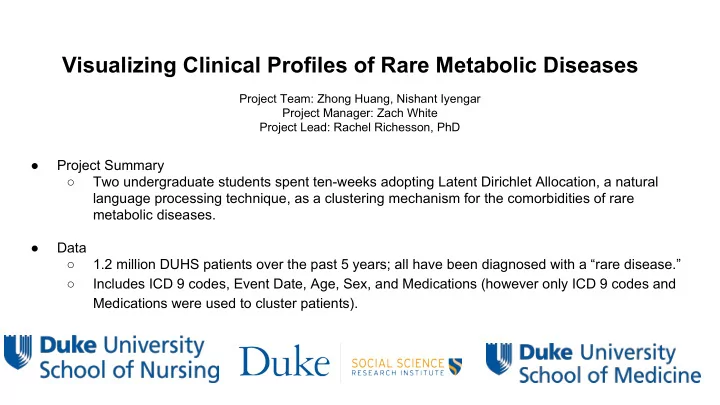

Visualizing Clinical Profiles of Rare Metabolic Diseases Project Team: Zhong Huang, Nishant Iyengar Project Manager: Zach White Project Lead: Rachel Richesson, PhD ● Project Summary ○ Two undergraduate students spent ten-weeks adopting Latent Dirichlet Allocation, a natural language processing technique, as a clustering mechanism for the comorbidities of rare metabolic diseases. ● Data ○ 1.2 million DUHS patients over the past 5 years; all have been diagnosed with a “rare disease.” ○ Includes ICD 9 codes, Event Date, Age, Sex, and Medications (however only ICD 9 codes and Medications were used to cluster patients).
Methodology & Model Validation ● Methodology: ○ After parsing out diseases populations from the larger data set, a long-format table was constructed that tallied the number of times a patient ID was associated with an ICD9 code. ○ Patients with <5 unique ICD9 codes and ICD9 codes appearing in >50% of all patients were discarded. The table also underwent TF-IDF down weighing, analogous to down weighing “stop words” in natural language processing. ○ The table was then fed into the Latent Dirichlet Model, implemented in the topicmodels package. ● Model Validation: ○ The K value (number of topics/clusters) was selected using the ldatuning package, which integrates metrics from Griffiths (2004), CaoJuan (2009), Arun (2010), and Deveaud (2014). ○ The K value was limited between 2 and 6 for practicality. ○ Only disease populations that could be modeled with a p-value of (approximately) 0 were selected for continued analysis.
Results / Next Steps The resultant model produces an optimal K clusters and the top ten most prevalent symptoms/medications in each cluster. Using Principal Component Analysis, it also visualizes the difference between different clusters. ● Next Steps ○ Invite more clinicians at DUHS to use our custom R Shiny interface to manually down weigh ICD9 codes that are irrelevant in a cluster (i.e. downweigh clinically known comorbidities). ○ Determine novel correlations between the comorbidities of rare metabolic diseases. ○ Conduct a more in-depth statistical analysis within clusters.
Recommend
More recommend